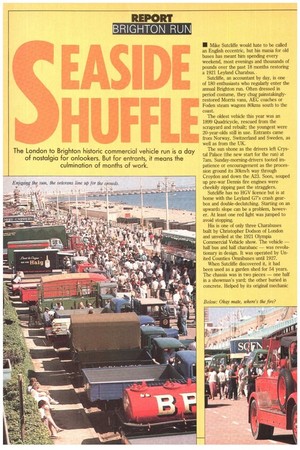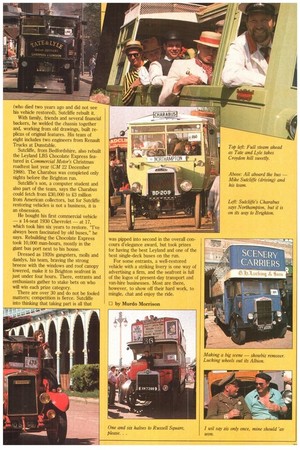EASIDE 1111F
Page 74

Page 75

If you've noticed an error in this article please click here to report it so we can fix it.
The London to Brighton historic commercial vehicle run is a day
of nostalgia for onlookers. But for entrants, it means the culmination of months of work.
• Mike Sutcliffe would hate to be called an English eccentric, but his mania for old buses has meant him spending every weekend, most evenings and thousands of pounds over the past 18 months restoring a 1921 Leyland Charabus..
Sutcliffe, an accountant by day, is one of 180 enthusiasts who regularly enter the annual Brighton run. Often dressed in period costume, they chug painstakinglyrestored Morris vans, AEC coaches or Foden steam wagons 80kms south to the coast.
The oldest vehicle this year was an 1899 Quadricycle, rescued from the scrapyard and rebuilt; the youngest were 20-year-olds still in use. Entrants came from Norway, Switzerland and Sweden, as well as from the UK.
The sun shone as the drivers left Crystal Palace (the new start for the run) at 7am. Sunday-morning-drivers tooted impatience or encouragement as the procession ground its 30km/h way through Croydon and down the A23. Soon, souped up pre-war Dennis fire engines were cheekily zipping past the stragglers.
Sutcliffe has no HGV licence but is at home with the Leyland G7's crash gearbox and double-declutching. Starting on an upwards slope can be a problem, however. At least one red light was jumped to avoid stopping.
His is one of only three Charabuses built by Christopher Dodson of London and unveiled at the 1921 Olympia Commercial Vehicle show. The vehicle — half bus and half charabanc — was revolutionary in design. It was operated by United Counties Omnibuses until 1927.
When Sutcliffe discovered it, it had been used as a garden shed for 54 years. The chassis was in two pieces — one half in a showman's yard; the other buried in concrete. Helped by its original mechanic (who died two years ago and did not see his vehicle restored), Sutcliffe rebuilt it.
With family, friends and several financial backers, he welded the chassis together and, working from old drawings, built replicas of original features. His team of eight includes two engineers from Renault Trucks at Dunstable.
Sutcliffe, from Bedfordshire, also rebuilt the Leyland LB5 Chocolate Express featured in Commercial Motor's Christmas roadtest last year (CM 22 December 1988). The Charabus was completed only nights before the Brighton run.
Sutcliffe's son, a computer student and also part of the team, says the Charabus could fetch from 230,000 to £.3 million from American collectors, but for Sutcliffe restoring vehicles is not a business, it is an obsession.
He bought his first commercial vehicle — a 14-seat 1930 Chevrolet — at 17, which took him six years to restore. "I've always been fascinated by old buses," he says. Rebuilding the Chocolate Express took 10,000 man-hours, mostly in the giant bus port next to his house.
Dressed as 1920s gangsters, molls and dandys, his team, braving the strong breeze with the windows and roof canopy lowered, make it to Brighton seafront in just under four hours. There, entrants and enthusiasts gather to stake bets on who will win each prize category.
There are over 30 and do not be fooled matters; competition is fierce. Sutcliffe into thinking that taking part is all that was pipped into second in the overall concours d'elegance award, but took prizes for having the best Leyland and one of the best single-deck buses on the run.
For some entrants, a well-restored vehicle with a striking livery is one way of advertising a firm, and the seafront is full of the logos of present-day transport and van-hire businesses. Most are there, however, to show off their hard work, to mingle, chat and enjoy the ride.
0 by Murdo Morrison
































































































































































































